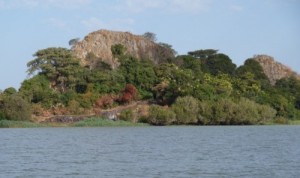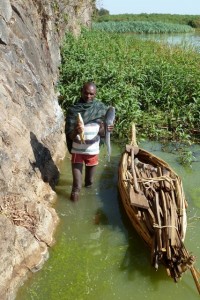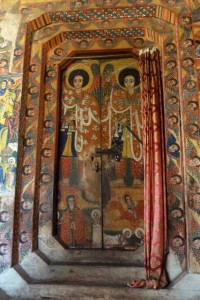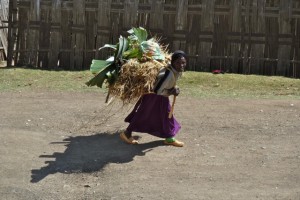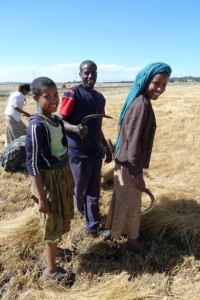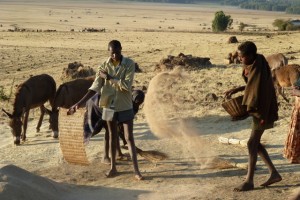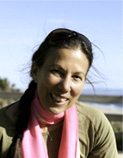Black crowned cranes flexing immense black and white wings in their signature flight style: necks and legs drooping in front and behind; Red cheeked cordon-bleu, a tiny flitting bundle of blue, like a plump madame garishly made up with a patch of rouge on each cheek; Malachite King fisher, a flash of iridescent blue/green diving into a papyrus marsh; the speckled mousebird, with a perky mohawk on its head and long mousey tail feathers; Black-winged lovebirds, faces ablush with carmine, a stripe of black on the outer edge of each green/yellow wing; African Paradise Flycatcher, handsome in bronze and black tuxedo, with a white slash of feathers trailing behind.
Look up these spectacular little birds, all of which live on the islands and shores of Lake Tana, the second largest lake on the entire African continent after Lake Victoria in Kenya. It’s like a vast sea, except it’s shallow, so the color is olive drab, rather than deep marine blue.
Dotting Lake Tana are 37 islands, many of which are home to ancient monasteries. By that I mean 500-, or 900-, or whatever-you-want-to-believe years old. A private pontoon boat took us 1.5 hours north from our lodge, which is in Bahir Dar on the the lake’s southern point. While Bernard inspected what are avowed to be the footprints of Mary and the hoofprints of her donkey, I sat on a peach-colored cliff peering through binoculars at the marshes. In the early morning haze of smoke and moisture, the distant hills were a pale pearl grey with a midnight blue edge defining their ridges. A few cows moved langourously into the emerald marshes spread below me, where grasses waved with the flutter of bird life. A lone fisherman wrapped in a green plaid shawl, poled his reed raft along the edge of the papyrus stands at the cliff base, catching tilapia and catfish in his net. Even on my high perch, smoke perfumed the warm morning air, and an old monk with rotten teeth and a pungent robe stood behind me, trying to get me to trade my watch for his.
This first monastery we visited forbade women from entering, so I couldn’t marvel at the rocky miracles Bernard got to see. But given the bird life on this island, I think I got the better part of the deal. At the remaining monasteries, I was accepted as an OK form of humanity, and allowed inside. I didn’t ask for a blessing though, since I felt that would have been disingenuous, atheist that I am.
All of this took place yesterday (Jan. 30), a day of great spiritual resonance and avian beauty, a day in which we docked at or walked to five monasteries. At each, the head monk opened creaking wood doors to his round church, each of which was roofed in thatch. Inside were walls painted floor to ceiling in well-preserved frescos, repeating the same pattern of story-telling: the life of Jesus, the life of Mary, Jesus’ childhood, and Jesus’ ministries and miracles. The churches are circular, to symbolizie the ultimate authority of God. Within, they’re divided into three concentric sections, representing the Father, the Son and the Holy Ghost. The outer circle has three entry doors: one for men, one for women and one for clergy. The middle circle has twelve doors, four for each of the three categories above, symbolizing the twelve apostles. The inner circle, into which only priests and deacons are permitted, again has three doors. As I learned yesterday, the Byzantine Church of which Ethiopia is a part uses a lot of threes, twelves, etc, not only in their churches, but in their magnificently ornate cross designs. I’m going to admit this was all a bit much for me to follow and remember, so if anyone reading this thinks I’m confused, you’re probably right. And I’ll bow to your superior knowledge on such things.
What was loveliest about these monasteries was not the churches themselves, but getting to each one; Boating over the smooth olive skin of the lake as black cormorants skimmed along and white armadas of pelicans drifted by; clambering up tree-sheltered stone paths to each church to be greeted by a wizened small man in a heavy mustard or purple robe, flat-topped skull cap on his head, ancient skeleton key in hand; walking some kilometers along the placid coast of the Zege Peninsula, shaded by immense gnarled trees, passing quiet lagoons dappled with sunlight, accompanied by the chatter of vervet monkeys and the occasional rustling scratch of a startled monitor lizard, giving the greeting of “selam” to the villagers using the same path as we.
Our trip so far has been an unexpectedly sensual and gripping experience. Though Addis is, to us, utterly avoidable and forgettable, intensely polluted and in many ways crumbling, it was an interesting experience being there during the week of the annual African Union meeting. Fleets of glossy Mercedes cruised up to our hotel entrance at all hours, diplomatic flags aflutter, lights flashing on the accompanying motorcycle escort, red carpet unrolled for Very Important Feet to walk on. We were the closest we’ll likely ever come to Bill Gates and Mr. Sarkozy, who were due to arrive the day we left.
Addis was remarkable primarily for the day we spent away from it, on a horseback ride in the Entoto Hills. Our Abyssinian ponies were slender as a fence rail and just about as comfortable to ride. Up, up and up we rode, passing through eucalyptus farms, emerging onto recently harvested gold fields, dotted with round thatch roof hut compounds. Eventually we spread a blanket on the ground near a eucalyptus grove, for a lunch of cheese sandwiches and chips at an altitude of 9500 feet, equal to our own Custer Mountain. It was hot, breezy and profoundly quiet, as we were in an area where there is no electricity. Thus there was no far-off rumble of an engine, a motor, a car, nothing. Just wind and the whispering hush of scented leaves brushing against each other. After lunch we rode down through farmland, passing huts from which kids ran out to stare silently at us as we rode by. Harvest is in full swing, every step of which is done without help of any machine. It’s like the Middle Ages. In one compound all the family livestock were at work threshing wheat, the goats, sheep, donkeys, cows and a pony all being thwhacked on the rump to keep them moving in a chaotic circle, trampling the wheat stalks.
Eucalyptus, by the way, is both the bane and the benefit of Ethiopia, imported here from Australia a century ago as a fast-growing source of wood for fires and construction. It still serves that purpose today, so well in fact that it’s resulted in the near-total eradication of native forests throughout the country…except on the islands on Lake Tana. Eucalyptus has the magical property of regenerating itself from its trunk, growing tall, reasonably straight limbs from its stump, which can be harvested every three years. But, there’s no native wildlife or birds that have adapted to these fragrant woods, so they’re strangely silent and empty. Farm wives make a bit of change harvesting eucalyptus for their own account, which they then carry the many miles to Addis on their back. We saw a small woman ease her way out of the woods with an enormous bundle on her back, easily 8 feet long, so long she had to sidle sideways through the trees. We figure it weighed 100 kilos, immensely heavy. She was literally bent double, supporting herself on a stick, and could barely lift her legs to take a step.
Everything else about Ethiopia has us completely in its thrall, especially the people. Leaving Addis we were happy to be free at last. We’re driving mainly on good paved roads, so the car part is not super-adventurous. But this is a country where people are easy to approach, so we pull to the side and walk into the fields when we see something interesting. We’ve gotten up close with every step of the harvest. . Bernard even tried his hand at cutting tif, which is the national grain used to make injera. After one whack with the terribly sharp hand-made scythe he was single-handedly responsible for sending an entire family into such gales of laughter they had to stop work. I considered adding to the comedy until the father of the group came up to me. He held out his tif-grabbing hand, with one finger bound in a scrap of green cloth, clearly a full knuckle shorter than any of the others. If even he could injure himself so severely, tif-cutting was not for me.
At another stop a day later, we spent an early morning squatting beside a family who were winnowing their tif harvest. Fields around us flatten into the far distance, covering thousands of acres. Every single blade growing in those fields is cut by hand, one grab and swipe at a time. By now, the fields are dotted with pale golden mounds of dried tif for miles. For winnowing, one kid uses a bowl-like basket to scoop up the grain. He flings the contents up into the air; as the grain settles back to the ground the lighter-weight chaff floats down last, falling on the surface. A second kid, with a reed mat the size of a big place mat, fans it vigorously over the fallen grain, to lift and blow away sticks and chaff and other litter. A small child pushes the cleaned tif into a growing pile. Then the process starts over again, the basket kid scooping from the big pile, flinging its contents onto the ground, to be fanned some more, until finally the tif pile contains absolutely nothing but grains the size of a poppy seed. Meanwhile, all the ground-matter is swept into its own pile, and a young girl takes a cookie-tin in which is inserted a fine mesh. She sieves all the droppings onto a sack, sifting out whatever grains have been lost in the flinging/fanning process. All the chaff, and of course the stalks, will be used for livestock feed. The tif will be ground to make injera. In halting English, the father of the group told us he had completed Grade 6. His daughter, she of the sieve, was in Grade 2. We offered her a nice pad of paper and a pen, for her school work, which drew a big, broad smile.
And so finally, we get to Bahir Dar. It’s the nicest town we’ve been in, modern, lined with palm trees and plush magenta and apricot bougainvillea, home to a big branch of the university and many government offices. For once there are a lot of shops and restaurants that look like shops and restaurants, rather than simple commerce shacks. Our first afternoon here, we noticed a parade of people walking down a red dirt side-road. Bernard swerved to follow them, weaving between huts where plastic tarps were laid out, with chick peas drying to gnarled bits in the sun. Barely a half-mile in, we parked and joined the procession. Everyone was dressed with a white shawl, a sure sign here that they’re on their way to a religious occasion. Turns out it’s the celebration day for Death of St. Mary and everyone’s heading to Debre Maryam (Maryam = Mary), a nearby monastery, to celebrate. Selam-ing as we go, we balance on black lava rocks that edge along green marshes of reeds and lily pads, filled with great white egrets, passing through groves of banana, mango and coffee trees. At one point we’re joined by a teenage girl who was walking back from the monastery with her mother and mother’s friend. She says hello and insists on turning around to accompany us to monastery.
It takes almost an hour, but finally we reach Lake Tana, just where the Blue Nile exits the lake to start its journey as one of the most important rivers in the world. From there, papyrus reed rafts are used to pole a few people at a time the 100 yards across the Blue Nile to the monastery. The rafts barely seem water-worthy, many so soggy it’s hard to believe they’ll stay afloat, but they do. None of this worries the thousand people chanting in celebration on the other side. That’s because they’re true believers, and I’m not. Anyway, with a 1000 of them over there jostling to get back to terra firma, it seemed it’d take hours for us to get back if we elected to cross to see the monastery that afternoon. While shoving my way to the front may work at Grand Central Station, it just did not seem the right way to behave here. We turned around.
To thank our impromptu guide, we give her a ride back to her house, which is one of the tin huts with thatch roof we’ve been driving by these past several days. Invited in, we sit on a little bench inside the 10×10 mud hut she shares with her mother. It has one bed and an Arsenal soccer poster on the wall, the family chickens scratching about the floor, the girl’sl and her mother’s few belongings stashed under the bed or against the wall. She offers us injera. We can’t refuse, but even I nearly gag on the small piece I accept. This is the real stuff, fermented for 3 days, rather than the commercially prepared injera which is fermented only for one day. It’s as sour as pickles, but flaccid and soggy. Try as I might, I couldn’t accept her generosity to have more. Then we reviewed with her her school books, which are in English. This teenager is so impressive, right on track to graduate in two years, polite, happy, relaxed. But she’s never seen a computer and, despite her aptitude, likely never will.
Today we spent the afternoon with a man who started chatting with me at an internet cafe. He fled Ethiopia in the early 60s, during the student uprisings of that time, and settled in Berkeley. He alluded to being part of the Black Panthers and such things, talking vaguely about coming back to Ethiopia some 10-15 years ago, after Mengistu was expelled. On these trips one can’t know the whole truth about people, only the impression they care to give. His impression was one of generosity as he invited us to his little farm spread, where we sat in a native-style gazebo and were served a delicious late lunch of injera (one day injera, this time!) with various things which I think are called “tibs”: golden pureed chick peas, brown ground flax seed, pearly ice with tomato, stewed blood-red shredded beets and more, washed down with a version of Arak which they call katikali, a strong sort of aguardiente, with a hint of licorice flavor. I’d had a belly ache earlier in the afternoon but two shots of this stuff cured it. He gave us a bottle to take with us on our trip. And he said he wants to buy Brunhilde, but who knows whether that was sincere or just the liquor talking!
-Dina









